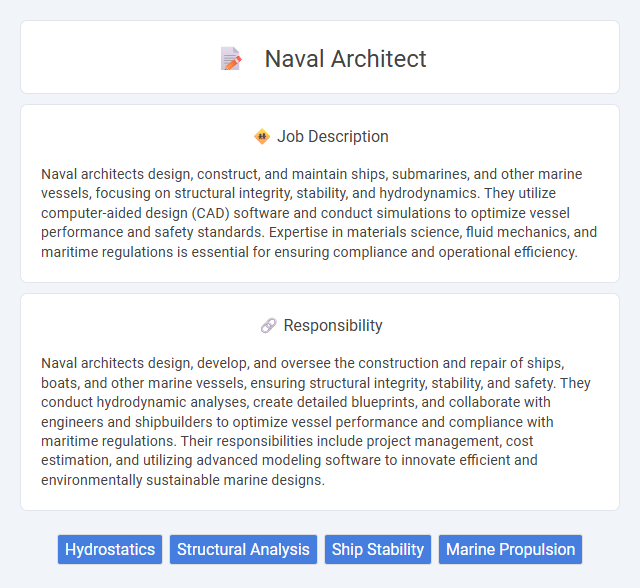
Naval architects design, construct, and maintain ships, submarines, and other marine vessels, focusing on structural integrity, stability, and hydrodynamics. They utilize computer-aided design (CAD) software and conduct simulations to optimize vessel performance and safety standards. Expertise in materials science, fluid mechanics, and maritime regulations is essential for ensuring compliance and operational efficiency.
Individuals with strong analytical skills and a passion for marine environments are likely to thrive as naval architects. Those who enjoy problem-solving, teamwork, and working in both office and shipyard settings may find this career fulfilling. Candidates who prefer routine tasks or limited physical activity might be less suited to the dynamic and sometimes demanding nature of naval architecture.
Qualification
Naval architects typically require a bachelor's degree in naval architecture, marine engineering, or a related field, emphasizing courses in fluid dynamics, structural analysis, and ship design. Professional licensure, often obtained through passing the Fundamentals of Engineering (FE) exam and acquiring relevant work experience, enhances career prospects. Proficiency in computer-aided design (CAD) software and strong knowledge of maritime regulations are essential qualifications for effective naval architecture.
Responsibility
Naval architects design, develop, and oversee the construction and repair of ships, boats, and other marine vessels, ensuring structural integrity, stability, and safety. They conduct hydrodynamic analyses, create detailed blueprints, and collaborate with engineers and shipbuilders to optimize vessel performance and compliance with maritime regulations. Their responsibilities include project management, cost estimation, and utilizing advanced modeling software to innovate efficient and environmentally sustainable marine designs.
Benefit
A career as a naval architect likely offers competitive salaries and opportunities for professional growth due to specialized expertise in ship design and marine engineering. The job may provide a stable work environment with the potential for involvement in innovative maritime projects and international collaboration. Benefits often include access to cutting-edge technology and the chance to contribute to sustainable and efficient vessel development.
Challenge
A naval architect likely faces complex challenges involving the integration of hydrodynamics, structural integrity, and safety regulations when designing vessels. Meeting performance requirements while optimizing fuel efficiency may require innovative problem-solving skills and advanced modeling techniques. Balancing cost constraints with technological advancements could continuously test an architect's adaptability and expertise.
Career Advancement
Mastery of naval architecture principles and software tools like AutoCAD and Rhino boosts career progression in this field. Gaining certifications such as Professional Engineer (PE) or becoming a Chartered Engineer (CEng) enhances credibility and opens leadership opportunities. Experience in project management and sustainable ship design further positions naval architects for senior roles and specialized consulting careers.
Key Terms
Hydrostatics
Naval architects specializing in hydrostatics analyze the buoyancy, stability, and trim of vessels to ensure safe and efficient watercraft design. They apply advanced computational methods and fluid dynamics principles to calculate displacement, center of gravity, and stability curves. Expertise in hydrostatics is critical for optimizing hull forms and predicting vessel behavior under various load conditions.
Structural Analysis
Naval architects specializing in structural analysis evaluate ship hulls and offshore structures to ensure strength, durability, and safety under various load conditions. They use finite element analysis (FEA) software to predict stress distribution, deformation, and failure points in marine vessels. Expertise in materials science, hydrodynamics, and maritime regulations is essential for optimizing design and compliance with classification societies like ABS and DNV.
Ship Stability
Naval architects specializing in ship stability analyze and design vessels to ensure they remain safe and operational under various sea conditions. They apply principles of buoyancy, center of gravity, and metacentric height to optimize stability during loading, unloading, and navigation. Advanced software tools and hydrostatic calculations are integral to modeling and assessing dynamic responses of ships to prevent capsizing and improve seaworthiness.
Marine Propulsion
Naval architects specializing in marine propulsion design and optimize propulsion systems to maximize vessel efficiency and performance. They analyze hydrodynamic forces, select appropriate engines, and integrate propulsion components like propellers and shafts to ensure fuel efficiency and compliance with environmental regulations. Advanced knowledge of fluid mechanics and marine engineering principles drives innovations in sustainable and powerful propulsion solutions.
 kuljobs.com
kuljobs.com